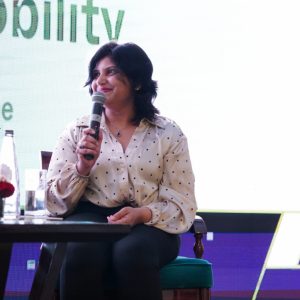India Transition towards a Greener, Cleaner Transportation System: An outlook with Ms. Shipra Misra
Ms. Shipra Misra, is the Chief Executive Officer and Managing Director of the Science and Technology Cluster in Delhi (DRIIV), an initiative supported by the Office of the Principal Scientific Advisor (PSA) to the Government of India (GoI). DRIIV aims to create an ecosystem where industry, academia, and government bodies collaborate to drive innovation from the laboratory to the market.
In a conversation with DWIH New Delhi, Ms. Misra, shares her insights on India’s journey to sustainable urban mobility, the role that technology will play in it, and the challenges and the incentives to the key stakeholders.

Ms. Shipra Misra
CEO & MD, City Knowledge Innovation Cluster- Science and Technology Cluster in Delhi (CKIC-DRIIV)
“In the area of renewable energy, energy storage is a huge issue.”
Can you tell us more about DRIIV and its activities?
DRIIV stands for Delhi Research Implementation and Innovation. It’s an initiative of the Principal Scientific Advisor (PSA) to the Government of India and the idea of the Science and Technology Cluster is pretty much how it operates in the West. In the West, this concept is fairly established. It is 30 to 40 years old and exists across Europe and parts of the USA. In India, this is a fairly new concept, we are one and a half years old. The idea is to create an ecosystem where industry, academia, and government bodies come and work together to take an innovation from lab to market.
We are headquartered out of IIT (Indian Institute of Technology)- Delhi, which is our nodal organization. The other members of the cluster include other premier academic institutes like All India Institute of Medical Sciences (AIIMS) and Government CSIR. Then we also work a lot with corporate, startups, and MSMEs, so the ecosystem is very large and thriving.
At COP26, India has committed to 50% of its energy requirements from renewable energy by 2030. If we look at the current scenario, India is largely dependent on coal for its energy. In this context what do you think is the role of mobility in the country’s ongoing energy transition?
Let me take a step back and look at commitment to the energy transition. Starting with the overall vision of becoming completely Net Zero by 2070 and working backward, we have to become energy self-sufficient by 2047. Of that the government has declared the objective of reducing carbon by 10 billion tons by 2030.And by 2030 itself 50 percent of the energy produced in India has to be renewable. Which involves 500-Gigawatt capacity installation etc.
Then amongst that, if you look at the energy consumption in the mobility sector, 14% of CO2 emissions are directly linked with transport and mobility. So, what are the ways in which we can cut down the emissions in Mobility?
One is switching to EVs, and the target is “30 by 30” which is 30 percent of the automobiles produced in India should be EVS by 2030. The other way is, and the government is pushing quite heavily for it, green hydrogen as a fuel. So, we will be utilizing fuel cells for mobility as well but, that is a little bit further off than immediately.
As the head of Science and Technology cluster in New Delhi which focuses on Urban Mobility, can you highlight some of the specific initiatives and projects that your cluster is undertaking in this regard?
The thematic areas that DRIIV has chosen are all aligned with national missions. We have a huge focus on Renewable Energy, Waste Management, Water Security, and Air Pollution, and then coming to other technology areas that impact sustainability like E-Mobility and Healthcare, etc.
Now within Mobility, the thematic area is anchored at IIT Delhi, and a lot of technologies have been developed in the CART lab. The CART stands for Center for Automotive Research and Tribology at IIT Delhi. There we have worked a lot with researchers, startups, and PSUs (Public Sector Undertaking) in creating technologies that can be taken to the market and some of them have already been taken to the market. I’ll give you a few examples. We have developed charging systems- a suite of charging systems, ranging from two-wheelers, three-wheelers, and four-wheelers to onboard chargers to fast chargers.
As of now, more than 380 Chargers have been installed across the country, in 17 cities. These have been developed in collaboration with startups and PSUs like HPCL and IPCL and the startup we are working with is, EVI Technologies. There are more in plan.
The other thing we have done is developed a battery-swapping system. Till the time we develop batteries that take less time to charge, we have to rely on battery-swapping systems. We have set up battery-swapping systems in collaboration with PSUs like Tata Power – DDL. We are also working on the charging infrastructure management system, because ultimately when you connect the chargers to the grid, there is a lot of grid management that’s also involved.
We have also launched an Android app that is being used through these startups that we’re working with. It helps locate the position of these charges and makes it easier for users to locate the charging infrastructure.
The technologies that I’ve so far mentioned are all being commercialized or taken to the market now. The way forward, the next challenge is a universal charger. Right now, every OEM has their own model, which makes it very difficult to make a replicable model and scale it up. IIT Delhi researchers along with researchers from various other IITs, have come together and they’re working on a universal charger design that can be deployed and scaled up nationally.
Then the other areas we are working on are “Vehicle to Grid” and “Vehicle to X”.
So, they (the researchers at IIT Delhi) are developing systems where EV batteries can also be used to feed into systems that consume energy, particularly in areas that are hard to navigate and where the electricity grid is not there, for example, remote rural areas.
What are some of the key challenges that India must overcome, to achieve Net Zero Emissions by 2070?
For Net Zero, the emphasis should be on renewable energy. India has demonstrated great success when it comes to solar power and wind power. The next objective or next goal for India is to create green hydrogen and India aspires to be a net exporter of green hydrogen. That is the next challenge we have to circumvent.
The Government of India has recently approved an INR Twenty Thousand Crore budget in the parliament that will be used to develop technologies related to Green Hydrogen and commercialize them. Then in terms of scaling up the EV and making it mainstream, there are still a number of challenges that need to be overcome. One is obviously the lack of charging infrastructure in our country.
I was just mentioning a couple of things that are still a hindrance. One is the technological challenge in terms of scaling them up and in terms of making them universal. Once we overcome those challenges it (achieving Net Zero Emissions) will be a lot easier.
Battery technology is another area of focus. We have to create batteries that are suitable for Indian conditions. So, for automobiles, we have reasonable designs but when it comes to two-wheelers and three-wheelers still a lot of work to be done in terms of increasing battery efficiencies, in terms of increasing the life of those batteries, etc. Then also in bringing the overall cost down, both in terms of the cost of the batteries and instruments as well as the operating cost a lot of work has to be done.
These are the challenges, but then there are clear policy incentives that will help overcome these challenges.
Listen to Ms. Shipra Misra, (CKIC-DRIIV) in a conversation with Ms. Tanya Bansal, (DWIH)

To play the video, click the thumbnail. Once activated data will be transmitted to the respective provider. Watch on YouTube
